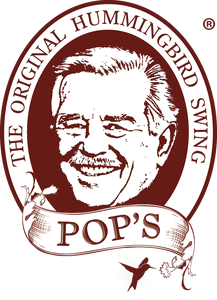Shop
Earn cashback on orders by sending invites to other retailers! Learn more.

Pop's Birding Company
California, United States
Featured Products
Shop
Our Story
"Enjoy as hummingbirds use the swing as a territorial perch to watch over their food."
When we tell people about our hummingbird swings the most common reaction is usually disbelief. People just don’t picture hummingbirds as the ‘swinging’ type. And for good reason, with an impressive wing beat rate of up to 100 beats per second and speeds in excess of 25mph, hummingbirds appear to always be on the go. But what people DON'T usually realize about hummingbirds is that they spend roughly 80% of their time perching! Usually in trees or fence-posts and just about anywhere they can keep a close eye on their food source!
And that was the realization our grandfather "Pop's" had himself years ago when he created the FIRST EVER Hummingbird Swing! One day he was sitting in his yard enjoying the company of his hummingbird friends when he noticed one particular hummingbird retreat to a nearby tree after feeding. At this sight, an idea pop’ed (no pun intended) into his head. “I wonder if he would perch on a swing instead?” And the rest is history.
The swing was a hit! Each day in between feedings the hummingbirds would stay and swing a little. Pretty soon there were more swings and there were more hummingbirds and then there were neighbors and friends asking for swings for their hummingbirds. One day it became clear to us Grand-kids that the rest of the world needed to be let in on the fun. So we set out on a mission and soon after began production. I'll never forget the look on our Papa's face the first time he saw the final product, all packaged and ready for retail (not to mention the logo of that fine-looking gentleman). It was a moment words really can't describe, but one that will be cherished in our hearts forever. A year later he passed away but we know that his legacy will live on through these swings. We're thankful for that first year that he got to see his idea turn into something bigger than all of us could have ever expected and we know he would be proud of where we are today.
We love you and miss you, Papa!
Bethany Sloan
Founding Partner / Managing Member
Policies & Help
Contact
Shipping Policy
Items are sent out 1-3 days after receiving them.
Refund Policy
Returns accepted in original packaging and resellable condition within 14 days of order placed
Frequently asked questions (FAQ)
Hummingbird Swings
Do hummingbirds really swing on it?
Yes! Hummingbirds are extremely territorial and spend 80% of their time perching. You just have to place the swing next to a feeder or nectar-rich flowering plant – something the hummingbirds will be territorial over - and they will use the swing as a territorial perching spot instead of retreating to a nearby tree to perch after feeding
Where should I place the swing?
We recommend hanging your swing close to the hummingbird’s primary food source (feeder or nectar-rich flowering plant). Place the swing eye level to the food source no more than 1-2 feet away. For optimal use, we do not recommend hanging the swing in a tree as there are too many competing perching spots.
How do I attract hummingbirds to my swing?
You shouldn’t have to do anything to “attract” hummingbirds to your swing. By placing it close to the food source, you will create an ideal perching spot and the hummingbirds should use the swing instinctively. If your hummingbirds do not see to be noticing the swing once it is hung, you can try placing the swing where the feeder is – then moving the feeder to a new location (eye-level, a foot away). Hummingbirds have an incredible memory and can remember the exact location of every food source they have visited – this will ensure they “discover” the swing on their next trip back to the feeder.
How do I make my area more desirable for hummingbirds?
The more desirable the location of your swing - the more likely hummingbirds are to become territorial over it and use as a perching spot. In addition to feeders, nectar-rich flowering plants are a great way to make your area more desirable to hummingbirds. Brightly–colored flowers that are tubular hold the most nectar, and are particularly attractive to hummingbirds. These include perennials such as bee balms, columbines, daylilies, and lupines; biennials such as foxgloves and hollyhocks; and many annuals, including cleomes, impatiens, and petunias.


